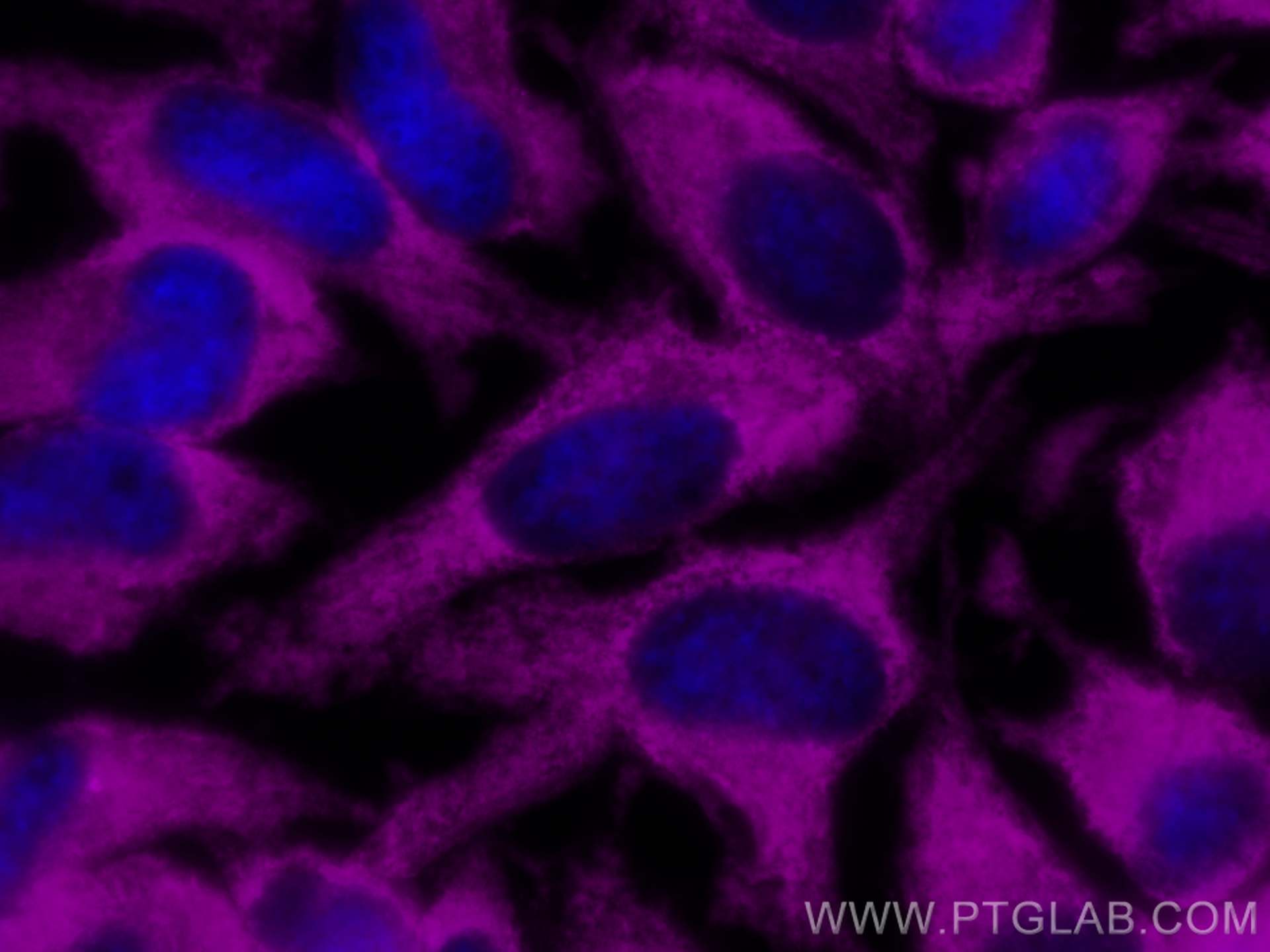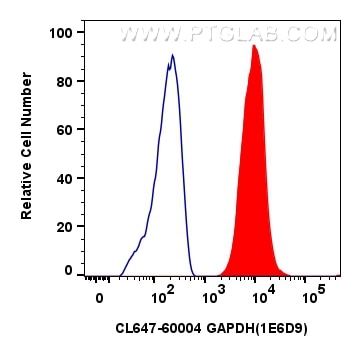- Featured Product
- KD/KO Validated
GAPDH Monoklonaler Antikörper
GAPDH Monoklonal Antikörper für IF/ICC, FC (Intra)
Wirt / Isotyp
Maus / IgG2b
Getestete Reaktivität
Hefe, human, Maus, Ratte, Zebrafisch
Anwendung
IF/ICC, FC (Intra)
Konjugation
CoraLite® Plus 647 Fluorescent Dye
CloneNo.
1E6D9
Kat-Nr. : CL647-60004
Synonyme
Geprüfte Anwendungen
| Erfolgreiche Detektion in IF/ICC | HeLa-Zellen |
| Erfolgreiche Detektion in FC (Intra) | HeLa-Zellen |
Empfohlene Verdünnung
| Anwendung | Verdünnung |
|---|---|
| Immunfluoreszenz (IF)/ICC | IF/ICC : 1:50-1:500 |
| Durchflusszytometrie (FC) (INTRA) | FC (INTRA) : 0.80 ug per 10^6 cells in a 100 µl suspension |
| It is recommended that this reagent should be titrated in each testing system to obtain optimal results. | |
| Sample-dependent, check data in validation data gallery | |
Produktinformation
CL647-60004 bindet in IF/ICC, FC (Intra) GAPDH und zeigt Reaktivität mit Hefe, human, Maus, Ratten, Zebrafisch
| Getestete Reaktivität | Hefe, human, Maus, Ratte, Zebrafisch |
| Wirt / Isotyp | Maus / IgG2b |
| Klonalität | Monoklonal |
| Typ | Antikörper |
| Immunogen | GAPDH fusion protein Ag0766 |
| Vollständiger Name | glyceraldehyde-3-phosphate dehydrogenase |
| Berechnetes Molekulargewicht | 36 kDa |
| Beobachtetes Molekulargewicht | 36 kDa |
| GenBank-Zugangsnummer | BC004109 |
| Gene symbol | GAPDH |
| Gene ID (NCBI) | 2597 |
| Konjugation | CoraLite® Plus 647 Fluorescent Dye |
| Excitation/Emission maxima wavelengths | 654 nm / 674 nm |
| Form | Liquid |
| Reinigungsmethode | Protein-A-Reinigung |
| Lagerungspuffer | PBS with 50% glycerol, 0.05% Proclin300, 0.5% BSA |
| Lagerungsbedingungen | Bei -20°C lagern. Vor Licht schützen. Nach dem Versand ein Jahr stabil. Aliquotieren ist bei -20oC Lagerung nicht notwendig. 20ul Größen enthalten 0,1% BSA. |
Hintergrundinformationen
What is the molecular weight of GAPDH?
The molecular weight of GAPDH is 36 kD.
What is GAPDH?
GAPDH stands for glyceraldehyde-3-phosphate dehydrogenase and is often referred to as a "housekeeping"
protein. It is recognized as an important enzyme involved in metabolic pathways, aiding in the glycolytic
production of ATP and pyruvate (PMID: 21895736).
What is the function of GAPDH?
GAPDH is responsible for catalyzing the phosphorylation of glyceraldehyde-3-phosphate into D-glycerate-1,3-biphosphate. While this function of GAPDH is considered its primary function, GAPDH is also involved, even
critical, in other cell functions, some of which are still being studied. Recent studies have suggested that GAPDH
is a key factor in regulating apoptosis, translocating to the nucleus under certain stressful conditions and acting
as a signaling factor in oxidative stress-induced apoptosis. Other studies indicate that GAPDH plays a role in
transporting vesicles from the endoplasmic reticulum to the Golgi body (PMIDs: 21895736, 12829261, 25859407,
11035021).
Where in the cell is GAPDH localized?
GAPDH is expressed primarily in the cytosolic and membrane regions, with minimal expression in the nucleus
(PMIDs: 21895736, 12829261).
Is there a reason to use an antibody targeting GAPDH if my research is not concerned with glycolysis or nuclear
functions?
Yes! Because GAPDH is often highly expressed throughout different tissues and cell types, GAPDH expression is
useful as a control for Western blots and RT-PCR.
What are the known protein-protein interactions of GAPDH?
GAPDH interacts with other proteins to regulate nuclear translocation and GAPDH catalytic activity. Some of
these proteins include TPPP, SIAH1, CHP1, RILPL1/GOSPEL and FKBP6 (PMIDs: 21895736, 25859407).
Note: For murine tissue samples, conjugated mouse antibody HRP-60004 and rabbit antibody 10494-1-AP are preferable.
Protokolle
| PRODUKTSPEZIFISCHE PROTOKOLLE | |
|---|---|
| IF protocol for CL Plus 647 GAPDH antibody CL647-60004 | Protokoll herunterladen |
| STANDARD-PROTOKOLLE | |
|---|---|
| Klicken Sie hier, um unsere Standardprotokolle anzuzeigen |



